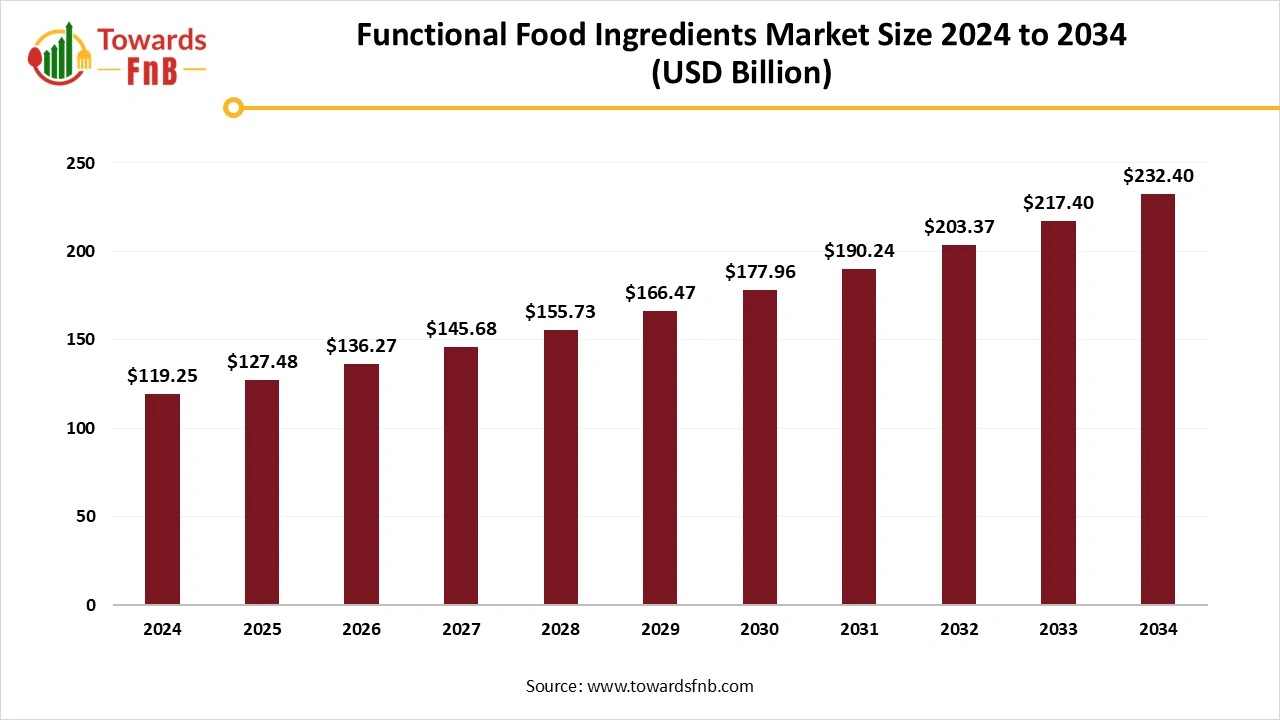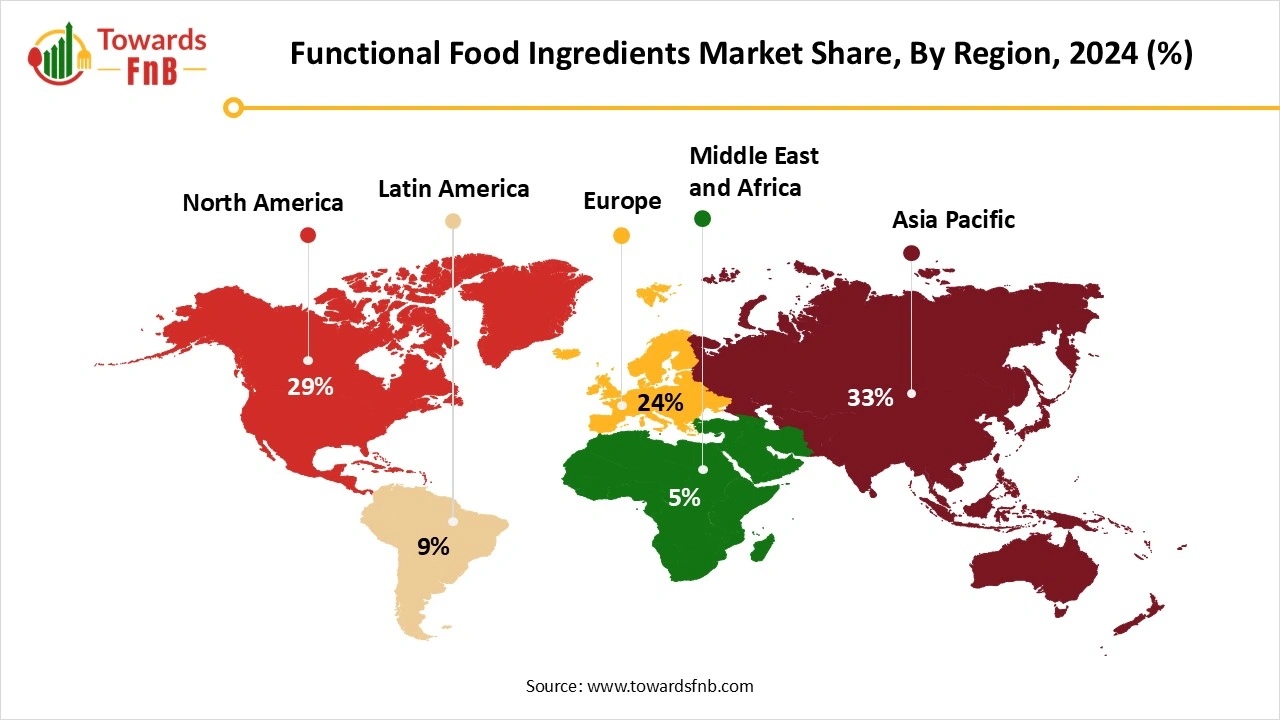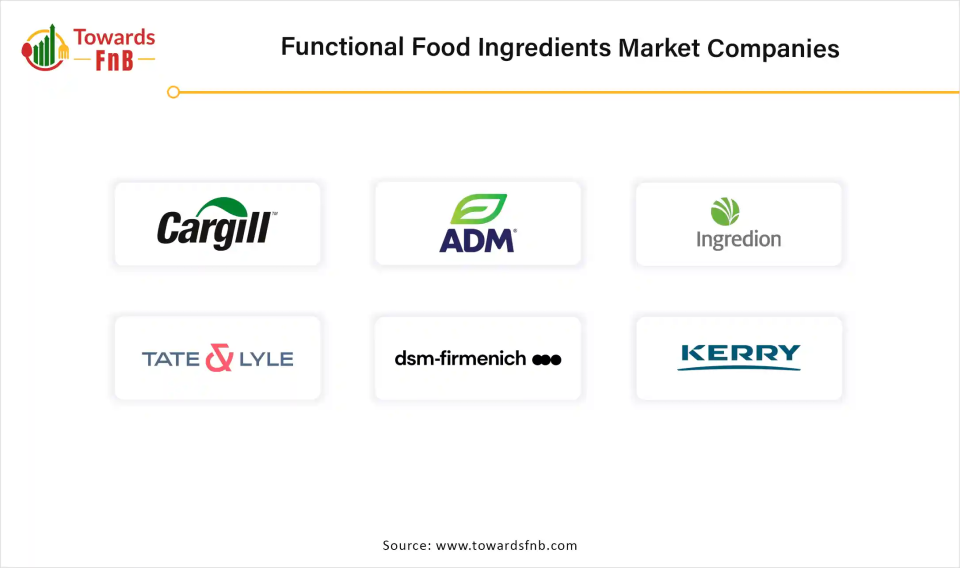December 2025
The global functional food ingredients market size reached at USD 119.25 billion in 2024 and is anticipated to increase from USD 127.48 billion in 2025 to an estimated USD 232.40 billion by 2034, witnessing a CAGR of 6.9% during the forecast period from 2025 to 2034. Growing health awareness among consumer and demand for the fortified food driving the market.

| Study Coverage | Details |
| Growth Rate from 2025 to 2034 | CAGR of 6.9% |
| Market Size in 2025 | USD 127.48 Billion |
| Market Size in 2026 | USD 136.27 Billion |
| Market Size by 2034 | USD 232.40 Billion |
| Largest Market | Asia Pacific |
| Base Year | 2024 |
| Forecast Period | 2025 to 2034 |
| Regions Covered | North America, Europe, Asia-Pacific, Latin America, and Middle East & Africa |
Functional food ingredients are components added to food and beverage products to provide specific health benefits beyond basic nutrition, such as gut health, immunity support, cognitive function, cardiovascular support, and weight management.
Rising health consciousness among the consumers, coupled with growing demand functional food products, is driving the market expansion. Due to the sedentary lifestyles and hectic schedules, there is rising prevalence of the chronic disorders. This has led to a growing demand for food products fortified with functional food ingredients to get a nutrient-rich diet.
The progress in technology and as a result, innovations in functional components. Businesses are continually creating new components that provide various health advantages, including lowering cancer risk and enhancing brain function. Progress in extraction, processing, encapsulation, and tailored nutrition is reshaping the functional ingredients sector, presenting thrilling opportunities for creativity and expansion. The market for functional ingredients is growing, as consumers seek increasingly holistic and life-improving advantages from their food. Startups focusing on functional food creation can take advantage of these trends by utilizing convenient ingredients such as adaptogens and plant-derived proteins. Major food corporations are also financing studies to enhance their functional food products.
As the demand for functional foods rises, regulatory agencies globally are ramping up their oversight of these products to guarantee safety, effectiveness, and proper labeling. This increased regulatory scrutiny requires thorough documentation, testing, and compliance steps at every stage of the product lifecycle, resulting in higher time and expenses for businesses. Dealing with intricate and changing regulations, particularly across various regions, introduces additional complexity and unpredictability. Businesses modify their formulas, production methods, and promotional tactics to meet different regulatory standards, which obstruct innovation and impede market expansion initiatives.
Asia Pacific dominated the functional food ingredients market and expected significant growth during the forecast period.
The need for functional food components in the Asia Pacific area is anticipated to grow in the next years due to various factors, such as rising instances of nutritional shortages and chronic diseases, along with new government fortification initiatives. The growth of the middle class in developing economies such as China, India, and ASEAN countries is generating a strong demand for premium, nutrient-rich foods. This demographic change is coupled with rising disposable incomes and a greater readiness to invest in health and wellness products. Food producers in the Asia Pacific area are consistently creating food items that incorporate functional components like omega-3s and probiotics to satisfy the increasing consumer demand for products offering diverse health advantages.

India's food ingredient scene is quickly changing as consumers lean toward plant-based, vegan, and clean-label options, motivated by a mix of urban growth, heightened health consciousness, and younger populations emphasizing nutrition and sustainability. Government initiatives like “Jaivik Bharat” and state-sponsored organic farming programs facilitate the growth of plant-based supply chains, while FSSAI guidelines promote clean-label assertions, enhancing consumer trust in plant-based products. A significant trend is the growing incorporation of natural food components in functional foods, fueled by the need for improved nutrition and immune-supporting items. Natural antioxidants (turmeric, amla), probiotics, and plant-derived proteins are gaining popularity. In reaction, the food sector is adjusting formulations to align with clean-label standards, thus increasing the demand for natural food components. This movement, backed by regulatory initiatives and the growth of digital retail, is poised to transform India’s food sector.
Which Ingredient Type Dominated the Functional Food Ingredients Market in 2024?
Probiotics segment led the functional food ingredients market in 2024. Increased consumer awareness regarding gut health and its link to overall wellness has greatly boosted the demand for probiotics. The increasing demand for consumer preference for preventive healthcare, coupled with the development of systematic probiotic strains, is mainly fueling the expansion of the market. The heightened awareness of preventive healthcare, influenced by elements like rising disposable income, enhanced living standards, and a growing elderly population, are additional key factors propelling the industry's growth. The 2022 International Food Information Council survey shows that one in three consumers looks for probiotics for their digestive health advantages. As consumer awareness increases that 70-80% of immune cells are found in the gut, the demand for products that support digestive health is rising.
Prebiotics/Synbiotics Segment is Observed to Grow at the Fastest Rate During the Forecast Period.
Increased awareness regarding digestive health and the gut-brain connection drives the demand for functional foods. Synbiotic products that combine probiotics and prebiotics promote healthy gut microbiota, enhance digestive health, bolster immunity, and increase nutrient absorption. Synbiotics serve as components in the food and beverage industry when found in yogurt items, smoothie, and snack food. The market is propelled by growing consumer awareness of the health benefits of prebiotics and expanded use of prebiotic in the animal feed sector to enhance digestion and bolster the immune system.
Which Source Segment Held the Dominating Share of the Functional Food Ingredients Market in 2024?
Natural (plant-derived) segment held the dominating share of the functional food ingredients market in 2024. Driven by increasing consumer awareness regarding health, sustainability, and product safety. Consumers are progressively looking for substitutes to synthetic chemicals, preferring items crafted from plant-derived or organic components seen as safer and more eco-friendly. Research and development initiatives are resulting in novel and creative food and drink items utilizing plant-derived and natural components. To remain competitive, suppliers of natural ingredients are utilizing advanced testing techniques, acquiring third-party certifications, and implementing sustainable sourcing methods.
Fermented/Microbial Segment is Seen to Grow at a Notable Rate During the Predicted Timeframe.
The increasing demand for organic and natural food items, along with the rising popularity of clean-label ingredients, is driving market growth. Improvements in fermentation technology are boosting production efficiency and product quality, resulting in more accessible and cost-effective fermented ingredients. Different kinds of microbial food components are incorporated into food items, including protective cultures, probiotic cultures, starter cultures, baking cultures, dairy cultures, fermenting cultures, and more, to satisfy the expanding diverse preferences of consumers.
Which Form of the Dominated the Functional Food Ingredients Market in 2024?
Powder/dry mix segment dominated the market with the largest share in 2024. Powders are incredibly adaptable and extensively utilized in numerous sectors such as food and beverage, pharmaceuticals, and personal care, largely because they can be easily integrated into formulations and possess a longer shelf life. This prevalence is anticipated to persist, driven by consumer desire for convenient, easy-to-use items such as protein powders and functional drinks.
Encapsulated/Microcapsule Segment is Expected to Grow at the Fastest Rate in the Market During the Forecast Period.
A major factor for growth is the advancements in encapsulation technologies. Methods like spray drying, freeze drying, and fluid bed coating have notably advanced, providing enhanced control over the release and bioavailability of the encapsulated components. These innovations have simplified the process for producers to integrate diverse active components into different food formulations without sacrificing the taste, texture, or longevity of the product.
Why did the Functional Beverages Segment Dominated the Functional Food Ingredients Market in 2024?
Functional beverages segment held the largest share of the market in 2024. An increasing number of consumers are currently looking for convenient solutions that can provide rapid functional advantages instantly, just by consuming a drink, without requiring any preparation time from them. A functional drinks is a beverage that offers a particular health advantage in addition to simple hydration. It generally includes additional components like vitamins, minerals, herbs, or other bioactive substances designed to aid a specific function or enhance health, including sports beverages, energy drinks, and vitamin-fortified waters. A noticeable shift is occurring towards drinks that offer specific functional benefits, like enhanced energy, improved digestion, and immune system support, as people become more health-aware.
Dairy Alternatives & Fermented Drinks Segment is Observed to Grow at the Fastest Rate During the Forecast Period.
This growth is fueled by a higher demand for plant-based diets, the global rise in lactose intolerance, and changing consumer preferences towards sustainable and ethical food options. The market is mainly influenced by elements like the increasing demand for probiotic beverages among health-aware consumers. Fermented beverages, such as kombucha, kefir, and various probiotic drinks, are an expanding area of the market for functional ingredients.
How did the Gut/Digestive Health Segment Dominated the Functional Food Ingredients Market in 2024?
Gut/digestive health segment led the market in 2024. This is motivated by increased consumer knowledge regarding the advantages of gut health and a significant emphasis on preventive healthcare. Rising demand for natural and functional components that promote gut health is a significant catalyst. Digestive issues like irritable bowel syndrome (IBS), Crohn's disease, and ulcerative colitis are growing more prevalent. This has resulted in an increased demand for products that can relieve symptoms and enhance digestive wellness. Consumers are increasingly focused on health and maintaining a balanced gut microbiome; the introduction of more effective and targeted ingredients along with advancements in food processing technology are key drivers boosting market growth.
Cognitive/Brain Health Segment is Seen to Grow at a Notable Rate During the Predicted Timeframe.
Professionals with busy schedules, students, athletes, and gamers alike are increasingly looking for methods to enhance their cognitive abilities. Numerous beneficial nutrients and bioactive substances, including vitamins, minerals, unsaturated fatty acids, dietary fibers, antioxidants, and more, can be included in functional foods for brain health. With the increasing consumer demand for brain health solutions, there is a parallel growth in the need for novel ingredients that can aid in maintaining a healthy brain.
Which End User Segment Dominated the Functional Food Ingredients Market in 2024?
Food & beverage manufacturers segment held the dominating share of the market in 2024. The worldwide increase in the need for food and drinks, particularly in regions like Asia Pacific, is resulting in significant expansion in this sector. Increasing disposable income, rapid urbanization, and evolving consumer tastes for functional foods are boosting market demand. The food & beverage industry is a significant application domain for functional ingredients, featuring a variety of products such as baked goods, dairy items, and snacks that include these components. Consumers are seeking greater functionality from food and drinks, desiring health advantages in addition to flavor and indulgence.
Nutraceutical/Specialty Brands Segment is Expected to Grow at the Fastest Rate in the Market During the Forecast Period.
Nutraceuticals are being utilized more frequently for different therapeutic results. Nutraceutical products are utilized not just for improved health results but also to lower the chances of heart disease, cancer, and other associated issues such as insomnia, cataracts, memory decline, menopausal symptoms, and gastrointestinal disorders. Typical components utilized in the production of weight loss nutraceuticals consist of beta glucan, herbal extracts, calcium, ginseng, green tea, green coffee, Guar gum, probiotics, and more.
Which Distribution Channel Dominated the Functional Food Ingredients Market in 2024?
Direct B2B sales segment dominated the market with the largest share in 2024. These direct agreements facilitate better pricing, bulk buying, and prolonged supply contracts. Leading producers in this industry cultivate strong relationships with global food companies, ensuring consistent demand. Direct channels enable enhanced customization of ingredients to cater to specific product requirements and offer technical assistance to manufacturers throughout the product development phase. For significant ingredient acquisitions, direct B2B channels provide enhanced efficiency and more streamlined processes than alternative distribution models.
E-commerce/Online Ingredient Marketplaces Segment is Observed to Grow at the Fastest Rate During the Forecast Period.
The surge in e-commerce has significantly created robust support for online sales of functional food items. Following the start of the pandemic, major producers are increasingly exploring popular e-commerce platforms by offering appealing discounts, strong sales and support, along with an improved shopping experience for buyers. This element is expected to assist online platforms in becoming one of the quickest-growing distribution channels worldwide.
Raw Material Procurement
Processing and Preservation
Quality Testing and Certification
Seadling
Arla Foods Ingredients
Louis Dreyfus Company

By Ingredient Type
By Source
By Form
By Application (Food & Beverage Categories)
By Function/Claimed Benefit
By End-User/Buyer
By Distribution Channel
By Region
December 2025
December 2025
December 2025
December 2025